Bulletin – June 2019 Australian Economy Wages Growth by Pay-setting Method
- Download 549KB

Abstract
Using job-level micro data, we show that the dynamics of wages growth differ across pay-setting methods. In recent years, wages growth has been strongest for award-reliant workers, stable at low levels for those on enterprise bargaining agreements (EBAs), and low but rising for those on individual arrangements. These trends reflect differences in the arrangements governing each pay-setting method, and differences in the types of workers covered by them. For instance, individual agreements react most flexibly to changes in labour market spare capacity, while government policies have kept public sector wages growth in EBAs relatively unchanged of late. This new disaggregation of wages growth allows for an estimation of the pass-through of award wage increases to other wage outcomes in the economy. We also find that the new breakdown provides a useful framework for forecasting aggregate wages growth.
Motivation
The low wages growth in recent years has contributed to a decline in the growth of household disposable income and consumption, and has been associated with a decline in inflation. Using job-level wage price index (WPI) data, we provide some key insights into the dynamics driving low wages growth. This analysis is the result of a recent collaboration between the Reserve Bank and the Australian Bureau of Statistics (ABS) using WPI data for around 18,000 jobs. Previous work using these data demonstrated that the decline in wages growth between 2012 and 2016 reflected a decline in both the average size of wage rises and the frequency of wage changes (Bishop and Cassidy 2017). In this article, we use the job-level WPI data to disaggregate wages growth by pay-setting method: awards, EBAs and individual arrangements.[1]
WPI growth declined across all three pay-setting methods between 2012 and 2016 (Graph 1). Since then, award wages growth has picked up as a result of Fair Work Commission (FWC) decisions to increase award and minimum wages at a faster pace than average. There has also been some pass-through of these award wage increases to workers whose pay is determined by other methods. Overall, however, there has been little change in average wages growth for workers on EBAs. This is because government policies have capped wages growth in most public sector EBAs, while delays in renegotiating some EBAs have resulted in a temporary wage freeze. Wages growth for those workers on individual arrangements has increased a little since its 2016 low, in part reflecting some pass-through of award wage changes, as well as the tightening in the labour market over this period.
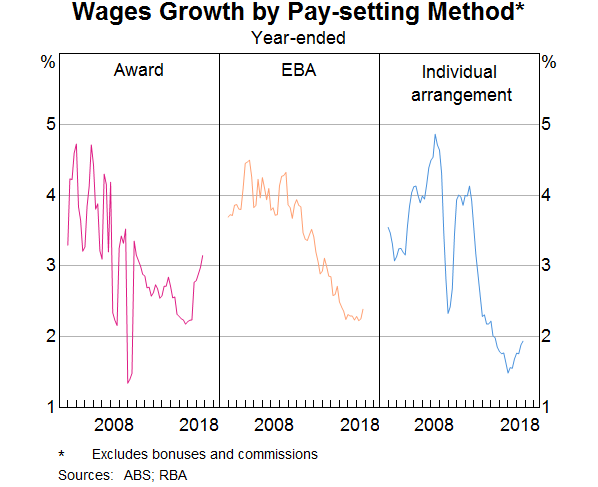
Pay-setting in Australia
As set out by the Fair Work Act 2009 (Cwlth) and other workplace legislation, the majority of Australian workers have their pay and workplace conditions set by one of three different methods: awards, EBAs and individual arrangements.[2]
Awards are legally enforceable determinations that set out minimum terms and conditions of employment in addition to any legislated minimum terms.[3] In recent years, the share of employees on an award or minimum wage (i.e. in an award-reliant job) has increased a little to around 20 per cent in 2018 (representing around 13 per cent of the total wage bill; Graph 2). Award-reliant workers tend to earn less per hour than workers who have their pay set by other methods. Award coverage is highest in some service industries and retail trade (Graph 3). Employees on awards are more likely to work part time, and around half of all award-reliant employees are engaged on a casual basis.
EBAs are collective agreements negotiated at the enterprise level between an employer and a group of employees. An EBA must leave an employee better off overall compared with the relevant award and the FWC is responsible for approving most agreements. The share of employees on EBAs has declined a little since 2010, to be around 40 per cent (Graph 2). As 80 per cent of public sector employees are covered by an EBA, EBAs are most prevalent in industries with a higher share of public provision, such as health and education.
Individual arrangements have wages and conditions set on an individual basis.[4] This is a broad category capturing all employees not on an EBA and not paid the exact award rate. The share of employees on individual arrangements has been around 40 per cent over the past two decades (Graph 2). Nearly all of these employees work in the private sector and most work on a permanent, full-time basis. Employees on these arrangements are also more likely to work in small-to-medium size firms and in the business services sector. Although some of these employees are paid close to the award (e.g. those paid a small fixed percentage above the rate of pay specified in the award), others are highly paid professionals and managers at the top of the wage distribution. Reflecting the relatively high average earnings for employees on these arrangements, they account for a larger share of the wage bill than those on EBAs.
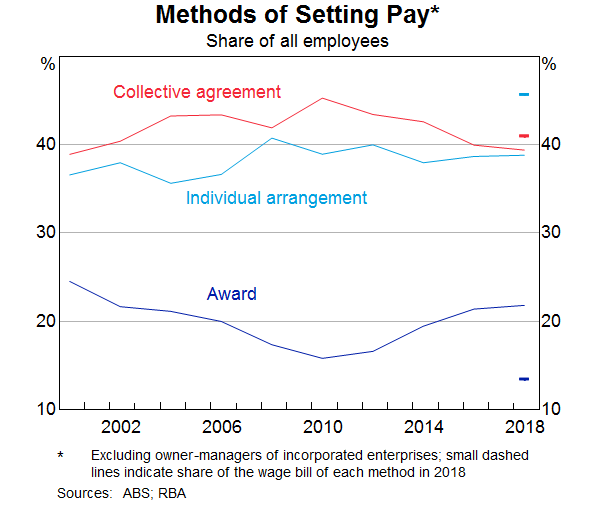
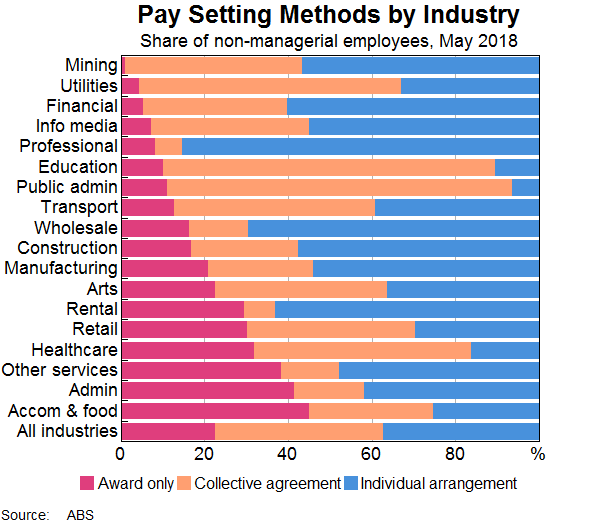
In the remainder of this article we consider the determinants of wages growth for each pay-setting method using the WPI micro data. The WPI is designed to measure changes in wage rates for a given quantity and quality of labour. It compares the wage for a given job across time, excluding any changes in wages resulting from changes in the nature of the job or the quality of the work performed. All measures in this article are of base hourly wages, excluding bonuses and commissions. The weight applied to each job in the WPI survey reflects that job's share of the total wage bill of the economy. However, the implied share of the total wage bill accounted for by each pay-setting method will differ from that reported in the Employee Earnings and Hours (EEH) survey, which is the ABS's preferred measure of the distribution of earnings across the pay-setting methods.
Awards
In its Annual Wage Review, the FWC decides what the increase in award wages in the national workplace relations system will be. On 1 July 2019, the FWC will increase all award wages by 3.0 per cent, following an increase of 3.5 per cent in the previous year (Graph 4). In undertaking these reviews, the FWC is required to consider a range of factors, such as the effects of its decision on inequality, relative living standards and needs of the low-paid, and various macro outcomes such as productivity, competitiveness, inflation and employment growth.
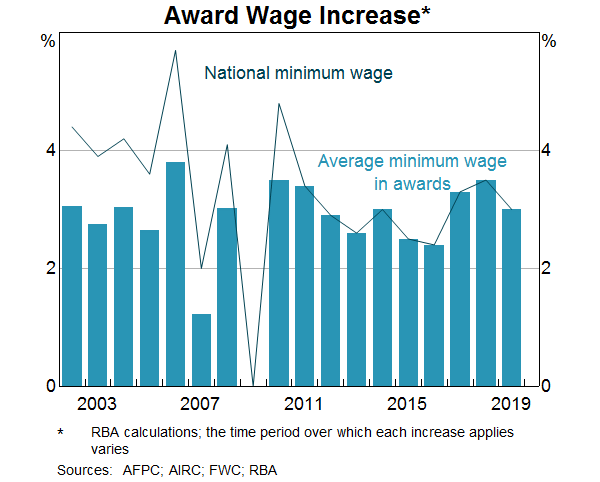
There is not necessarily full pass-through of FWC award wage decisions to the wages of those workers in award-reliant jobs because firms might not comply with the ruling. Nevertheless, the job-level data suggest there is considerable pass-through of award wage changes to wages for award-reliant jobs, as measured by the WPI. To see this, we need to distinguish between the ‘modern awards’ set by the FWC (which cover most award-reliant employees) and awards determined by separate state industrial commissions. Several state industrial commissions continue to set award wages for some employees. When we restrict the data to jobs covered by modern awards, there tends to be a tight relationship between the size of FWC increases and the size of wage rises for award-reliant jobs (Graph 5).[5] This is consistent with earlier analysis for the 1998 to 2008 period, which found that changes to awards were almost fully passed on to wages in award-reliant jobs (Bishop 2018). This earlier analysis also found no evidence to suggest that the modest, incremental increases to award wages during that period had an adverse effect on hours worked or the job destruction rate for award-reliant jobs.
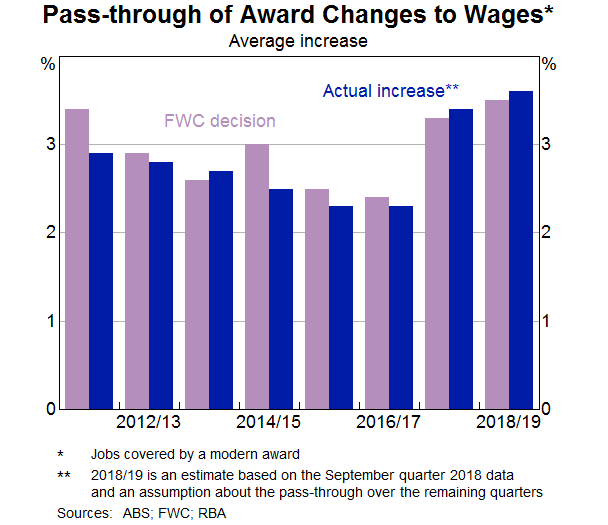
The recent step-up in the size of FWC adjustments has provided support to wages growth at the lower end of the skill distribution, given the prevalence of award-reliant jobs in this part of the labour market. Wages growth for the least-skilled jobs (as defined by the ABS) has outpaced all other skill groups since around 2013 (Graph 6). This contrasts with the commodity price boom period, when wages growth was strongest for higher-skilled jobs. Consistent with this, the ratio of average hourly earnings of award reliant employees to those of other employees has risen since 2012, largely reversing the falls seen in the earlier period.
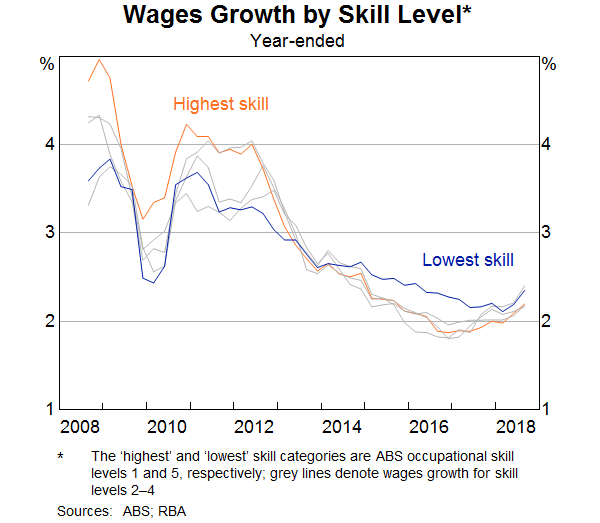
The four industries with the highest shares of award-reliant employees are accommodation & food services, administrative & support services, other services and retail trade. In these industries, more than 30 per cent of all employees are paid the award rate. Despite this, overall wages growth in these industries has not picked up materially because wages growth in the other pay-setting methods has been weak (Graph 7). This has occurred in part because wage freezes (where wages are unchanged for one year or longer) have become more common.
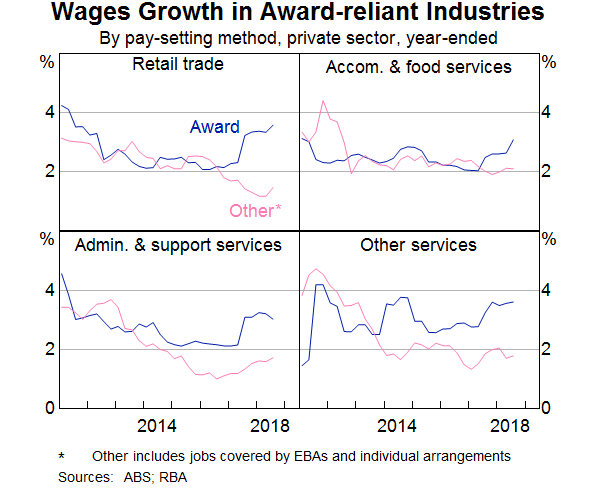
Enterprise Bargaining Agreements
EBAs can be negotiated with or without union involvement although, under current legislation, unions are the default bargaining representatives of the employees provided that at least one of their members would be covered by the agreement. EBAs tend to have a duration of around three years; after the nominal expiry date, the terms and conditions in EBAs continue to operate until they are replaced with a new EBA or terminated by the FWC.
Wages growth in EBAs has been relatively steady at a low level in recent years. This reflects that public sector workers account for around two thirds of EBA employees and government policies have been in place in many jurisdictions to keep public wages growth steady at 2.5 per cent in recent years (Graph 8). There have, however, been some clear differences in recent outcomes across the public sector. Average wages growth for Commonwealth government jobs was around 1 per cent between 2014 and 2017, as protracted negotiations over new EBAs led to widespread wage freezes. Western Australian public sector wages growth is now the lowest across state governments following a period of above-average growth during the mining boom, while Victorian public sector wages growth has been relatively strong in recent years due to many workers receiving wage increases of around 3 per cent.
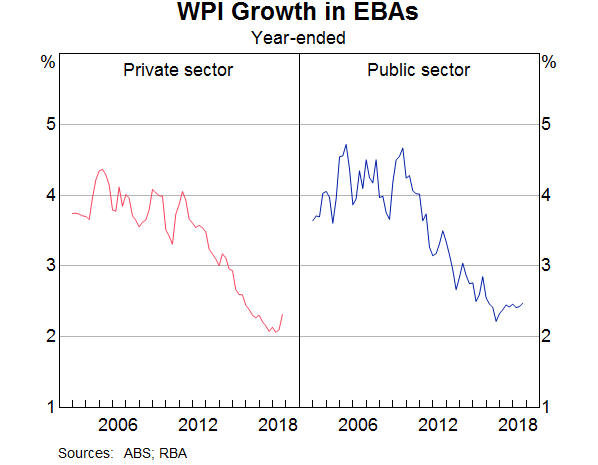
Within the private sector, wage freezes have become increasingly common due to lengthy negotiation delays for new EBAs. This has been most evident in the retail trade industry, with several of the major retailers operating under expired EBAs for an extended period of time during which employees' wages are frozen. More recently, several large retailers have signed new EBAs which should increase average wages growth in the industry.
Average wages growth for EBAs adjusts relatively slowly to changing conditions in the labour market because a new agreement is typically negotiated only every three years. However, wages growth in new EBAs can provide some leading information about the likely direction of average EBA wages growth. Information on wage outcomes in new EBAs is available in the Department of Employment, Skills, Small and Family Business Workplace Agreement Database (WAD). The WAD contains information on all federally registered EBAs, including the annualised average wage increases (AAWI) over the duration of the agreement and the nominal expiry date for each agreement. The AAWI in new private sector EBAs declined steadily between 2012 and 2017 (Graph 9). As expiring EBAs were replaced by new EBAs that had lower average wage growth outcomes, average EBA wages growth in current agreements also declined. More recently, the AAWI for new private sector EBAs has increased, which will put upward pressure on average EBA wages growth over time.
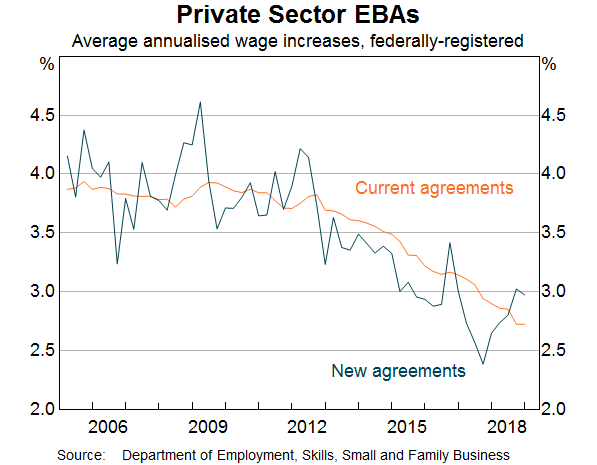
There are several important differences in how wages growth in EBAs is measured in the WPI and the AAWI. The AAWI measure does not capture the effect of wage freezes, while the WPI measure has been dampened by the effect of workers receiving no change in their pay for a period of time. The AAWI also only captures those agreements where wage increases are ‘quantifiable’. That is, if wages in an EBA are linked in some way to something that cannot be quantified at the outset of the agreement, such as future FWC decisions or CPI outcomes, then they are not captured in the AAWI. This also includes cases where an EBA provides different wage rises for different groups of employees, or links wage increases to performance. Finally, the WAD will only include federally registered agreements, so will not capture AAWI for EBAs for most state public sector workers. Nevertheless, the AAWI for new agreements remains a key source of information for the outlook of aggregate wages growth.
Individual Arrangements
Wages set by individual arrangements tend to be more responsive to the economic cycle than wages set by other pay-setting methods. In particular, the inverse relationship between wages growth and the unemployment gap, known as the wages Phillips Curve, is stronger for those on individual arrangements than for other pay-setting methods (Graph 10).[6] We find that a 1 percentage point decline in the unemployment gap tends to increase annual wages growth for jobs on individual arrangements by around 1.1 percentage points, which is larger than the response for EBAs and awards. Further analysis suggests that this does not simply reflect that individual arrangements are more prevalent in cyclical industries, such as mining and professional, scientific & technical services.
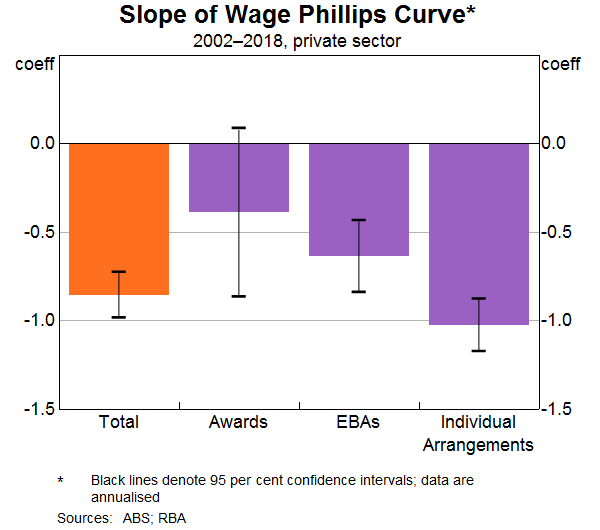
The cyclical sensitivity of individual arrangements was evident during the 2000s mining boom. During the boom, wages growth for jobs on individual arrangements in mining and mining exposed parts of the labour market rose strongly, as competition for labour intensified (Graph 11). Then from 2012, wages growth declined sharply as demand for labour softened after the boom. Wages growth for individual arrangements also fell sharply when the unemployment rate increased in 2009. By comparison, wages growth for EBAs was broadly unchanged over these periods (Graph 1). The cyclical sensitivity of individual arrangements, along with their large weight in the wage bill, means they account for much of the high-frequency cyclical variation in the WPI.
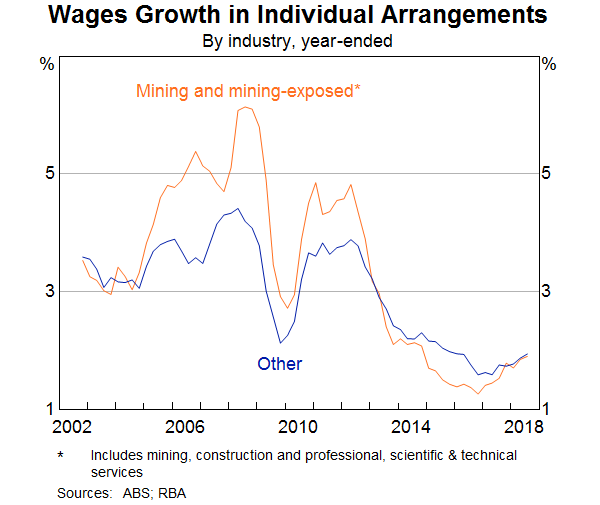
Although wages growth in individual arrangements is more responsive to changes in demand, the wage levels for these arrangement are still very rigid downwards. That is, while firms adjust the growth rate of wages in response to changing demand, they are usually unable or unwilling to cut the level of wages. The share of jobs on individual arrangements that experienced cuts to their base wage was only 4 per cent between 2011 and 2014, and is now less than 2 per cent. Rather than seeing wage cuts during a period of ample spare capacity in the labour market, workers on individual arrangements were frequently subject to wage freezes (Graph 12). Indeed, until recently, close to 40 per cent of all jobs on individual arrangements had their wages frozen for at least a year.[7] However, even during periods of strong labour demand, around one in every four jobs on individual arrangements tends to have their pay reset less than once a year.
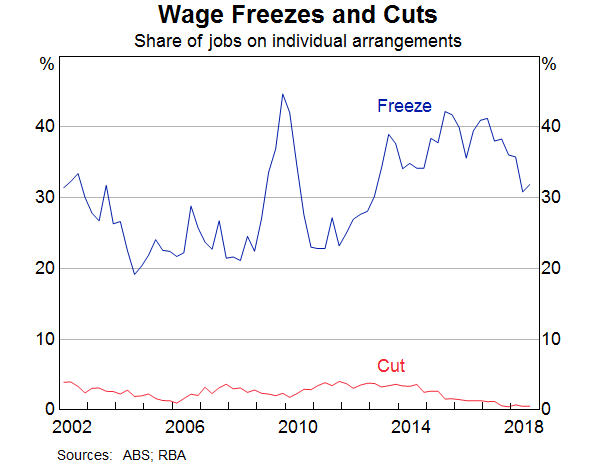
Year-ended wages growth for individual arrangements has picked up recently, rising by ½ percentage point since 2016 (Graph 1). Two thirds of this recovery has been driven by a cessation of earlier wage freezes. The average size of wage changes – conditional on a change – has also ticked up slightly for jobs on individual arrangements. In part, these developments reflect the decline in the unemployment rate over the period, which our analysis suggests will show up first in wages growth for individual arrangements before any other pay-setting method. Part of the recovery also reflects spillover effects from the larger-than-average award increases, as discussed below.
Effect of the Annual Wage Review on Other Wages
The FWC's Annual Wage Review can affect wages for those on individual arrangements or EBAs. For example, some employees on EBAs or individual arrangements have their wages set above the award, but are directly linked in some way to FWC decisions.[8]
Using the micro WPI data, we use two methods to estimate the share of ‘award-influenced’ jobs. These estimates will essentially be a lower bound because they only capture direct effect and cannot capture indirect effects, such as a change to other wages within a firm to maintain wage differentials between award-reliant and other employees.[9] The first method uses information provided by a firm in the WPI survey about why a particular job's wage changed in the quarter. For EBAs and individual arrangements, we can estimate the share of award-influenced jobs by looking at the share of wage changes for which ‘FWC decision’ or ‘State wage case’ was listed as a factor contributing to the wage change.[10] This suggests that around 12 per cent of all wage changes in EBAs and 8 per cent of all wage changes in individual arrangements (after accounting for each job's overall weight in the WPI) are influenced by award decisions (Graph 13). The share of jobs on individual arrangements for which pay is influenced by award decisions has more than doubled since 2012.
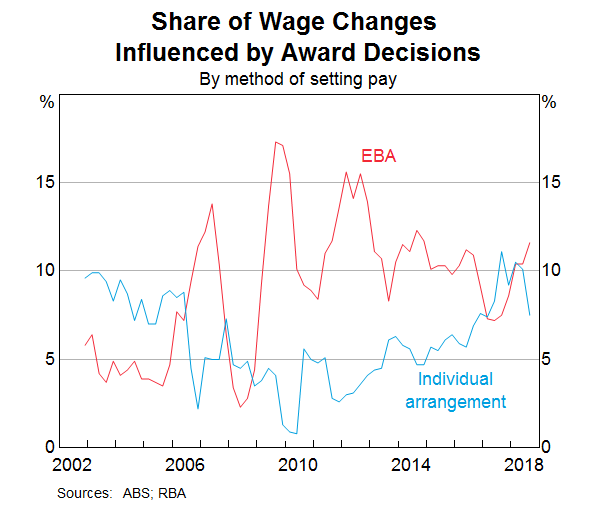
The second method is to look for evidence of a clustering of wage changes around FWC decisions. To see this, we compute the wages growth for all jobs covered by an EBA or individual arrangement in recent years, and then ‘re-centre’ them on the FWC increase for that year by subtracting the size of the FWC increase (Graph 14). This shows that around 6–6½ per cent of jobs on EBAs and individual arrangements had wage rises that fell within ±0.05 percentage points of the FWC decision between 2015 and 2017. The reason these estimated shares are smaller than those estimated using the first approach is that this method can only identify cases where the job received the same percentage wage increase as the FWC outcome. For example, in some of the retail EBAs that have recently been agreed upon, new employees will be paid a fixed dollar amount above the wage specified in an award, but will generally receive a smaller percentage increase in their hourly wage than that announced by the FWC.
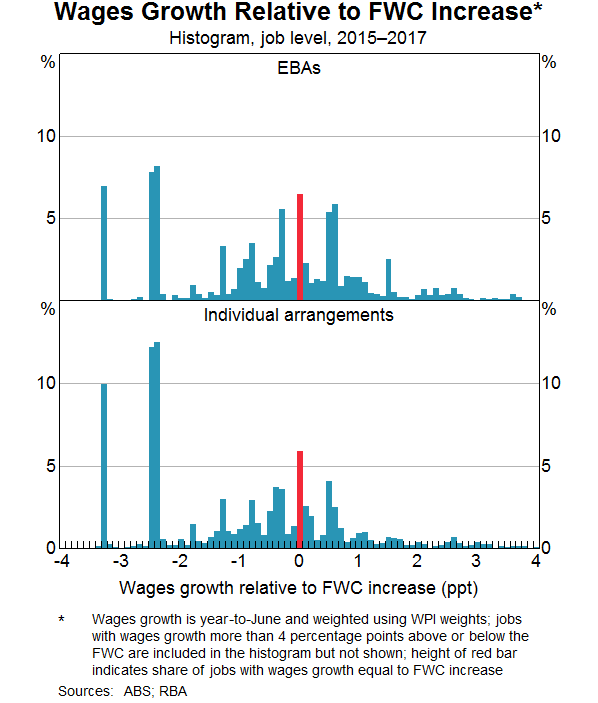
In addition to the increase in the share of individual arrangements linked to FWC decisions as reported in the WPI survey, data from the WAD suggests that there has also been a recent increase in private sector EBAs that have pay rises that will be linked automatically to FWC award decisions; this includes a number of the larger retail EBAs that have been negotiated over the past year.
This analysis is useful in estimating the overall contribution of FWC decisions to aggregate wages growth. However, it is less appropriate for estimating how many jobs have wages that are affected by FWC decisions. The share of jobs affected by FWC decisions is likely to be higher than the (wage-bill-adjusted) shares presented in this section because jobs with wages linked to FWC decisions are likely to be paid less on average than other jobs in the same pay-setting stream, and therefore have lower wage-bill shares. This also helps to reconcile why the WPI micro data appear to generate smaller estimates of award spillovers than Wright and Buchanan (2013), who found that around 20 per cent of private sector employees surveyed had their pay ‘set, influenced or guided’ by the award (excluding those on EBAs with pay rises linked to awards).
Outlook for Wages Growth
Differences in wage dynamics across the pay-setting methods suggest there is value in deriving separate wages growth forecasts for each method, which can then be aggregated using their expenditure weights in the EEH. While the data on wages by pay-setting method are not currently updated by the ABS on an ongoing basis, considering the outlook for wages based on the available data discussed here can provide a useful cross-check on conventional forecasts of economy-wide wages growth. It is also be useful for scenario analysis, including modelling the impact of award wage increases or a change in government policies for public sector wages.
To forecast awards, we use recent actual outcomes and judgement about the likely future outcomes of the FWC's Annual Wage Reviews to project wages growth over the two years of the forecast period. Judgement is used for future outcomes because the broad considerations and objectives of the FWC in the Annual Wage Review make it difficult to model award wages growth statistically using the traditional determinants of wages growth. The 3.0 per cent increase in award wages from 1 July 2019 is expected to directly contribute around ¼ percentage points to aggregate wages growth over the year, which is similar to recent years. However, as discussed earlier, the contribution of the FWC's Annual Wage Review to aggregate wages growth as measured by the WPI may differ from this estimate to the extent that the WPI uses a different assumption to the EEH about the wage-bill share of award-reliant employees.
For EBAs, we largely use information from the WAD on federally registered EBAs to develop forecasts. We also collect similar information for current public sector EBAs that are not captured in the WAD. Because EBAs can lock in a profile of wage rises for up to four years, we can be quite certain about the wage outcomes of those agreements up to the nominal expiry date. If an agreement expires during our forecast period, we assume it is rolled over to a new agreement with a wage outcome that is consistent with government policies for public sector wages and other factors, such as the state of the labour market, which is forecast to strengthen a little further in the next couple of years. Average wages growth for EBAs is expected to increase a little over the next few years, as wage freezes are expected to become less common and as wages growth in new private sector EBAs moves higher.
As wages growth in individual arrangements were shown to have the tightest relationship with the unemployment gap, we use the specification of our preferred Phillips Curve model for private sector WPI growth to forecast wages growth for individual arrangements. The model includes variables capturing growth in domestic prices, changes in the unemployment rate, the unemployment gap, inflation expectations and lagged wages growth. The model ‘fits’ the data better for individual arrangements than for other wages; around 82 per cent of the variation in wages growth for individual arrangements over the period 2002–18 can be explained based on these cyclical factors. For this reason, these wages can be thought of as a bellwether for broader wage pressures arising from a tight labour market (or conversely, disinflationary pressure from excess labour market slack). Overall, we expect the forecast gradual tightening of the labour market over the next couple of years to feed through into slightly stronger wages growth for those on individual arrangements. However, one risk to the outlook is that those firms that had been unable to reduce wages during the period of ample capacity may instead give their employees smaller wage rises than usual as the labour market tightens.
Overall, these outlooks for the various pay-setting methods support the forecast for wages growth as published in the Bank's recent Statement on Monetary Policy, which suggests a gradual pick-up in wages growth over the next couple of years.
Conclusion
Disaggregating wages growth by pay-setting method has improved our understanding of the drivers of the low wages growth in recent years. The disaggregation can also be used to produce a more detailed outlook for wages growth. At this stage, this disaggregation is not available to be updated by the ABS on a regular basis. Nevertheless, using this framework and the available information on wages growth for each pay-setting method, such as award wage decisions and new EBAs, can usefully inform our outlook for wages growth on an ongoing basis.
Footnotes
James Bishop is from the Economic Research Department and Natasha Cassidy is from the Economic Analysis Department. The authors would like to thank the Prices Branch at the ABS, in particular Darryl Malam and Luci Burrage, for sharing their time and expertise. [*]
The period covered in this analysis is March quarter 2002 to September quarter 2018. The ABS has also conducted analysis of the WPI by pay-setting method (Page 2018). [1]
This analysis excludes owner-managers of incorporated enterprises as they determine their own rate of pay. In 2018, these workers accounted for 6 per cent of total employment. [2]
In Australia, the National Minimum Wage sets a legal floor on wages. There is also a detailed system of award wages that are layered on top of the National Minimum Wage, and these rates depend on the industry, age, skill level and qualifications of an employee. In this analysis, employees are classified as award reliant if they are paid at the rate of pay specified in the relevant award. [3]
An individual arrangement can include an individual contract, individual agreement registered with a Federal or State industrial tribunal or authority, common law contract (including for award- or agreement-free employees), or an agreement to receive over-award payments. [4]
The WPI data show that four fifths of the wage adjustment to FWC decisions comes through in the September quarter, although some award-reliant jobs also experience wage adjustments in subsequent quarters. Graph 5 calculates the cumulative change in wages from the June quarter prior to the FWC decision to the June quarter of the following year. [5]
The slope coefficient is estimated using a simple regression of annualised quarterly wages growth on the first lag of the unemployment gap (difference between the unemployment rate and the Reserve Bank's estimate of the non-accelerating inflation rate of unemployment (NAIRU)). Confidence intervals are based on Newey-West standard errors. [6]
A broader measure of hourly earnings that include bonuses also displays downward rigidity, but to a lesser extent than base wages. [7]
In some cases, these ‘spillovers’ are even more direct. For example, some employees classified by the ABS as being on an EBA have their wage set at the exact award rate. These employees are generally entitled to receive the full award increase handed down by the FWC. This classification reflects that there are other non-monetary conditions in the EBA that separate it from the Award conditions. [8]
Influential surveys by Bewley (2002) suggest firms are acutely aware that their workers make wage comparisons with their colleagues. In Australia, awards also provide the benchmark for the ‘better off overall test’ for EBAs. See Autor, Manning and Smith (2016) and Low Pay Commission (2019) for recent empirical estimates of spillover effects for the United States and United Kingdom respectively. [9]
The other response options in the survey are ‘Change in grade or class’, ‘Change in age scale or increment within level’, ‘Collective agreement’, ‘Salary review’ and ‘other’. Data on the sources of wage changes are available in around 70 per cent of all instances in which a wage change is observed. We restrict our attention to the sample of wage changes for which information on the source of the wage change is available. [10]
References
Autor D, A Manning and C Smith (2016), ‘The Contribution of the Minimum Wage to US Wage Inequality over Three Decades: A Reassessment’, American Economic Journal: Applied Economics, 8(1), pp 58–99.
Bewley T (2002), Why Wages Don't Fall during a Recession, Harvard University Press, Cambridge.
Bishop J and N Cassidy (2017), ‘Insights into Low Wage Growth in Australia’, RBA Bulletin, March, pp 13–20.
Bishop J (2018), ‘The Effect of Minimum Wage Increases on Wages, Hours Worked and Job Loss’, RBA Research Discussion Paper No 2018-06.
Low Pay Commission (2019), ‘20 Years of the National Minimum Wage: A History of the UK Minimum Wage and its Effects’, April.
Page D (2018), ‘Wage-Setting Methods and Wage Growth in Australia’, ABS Chief Economist Series, August.
Wright S and J Buchanan (2013), Award Reliance, Research Report 6/2013, Fair Work Commission, Melbourne.